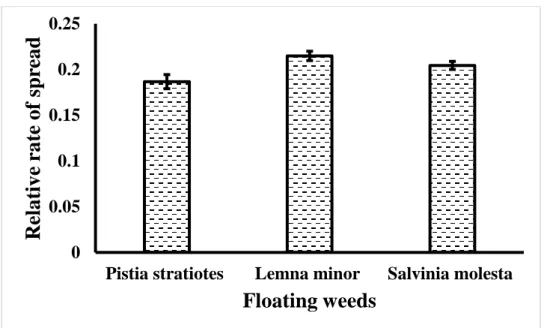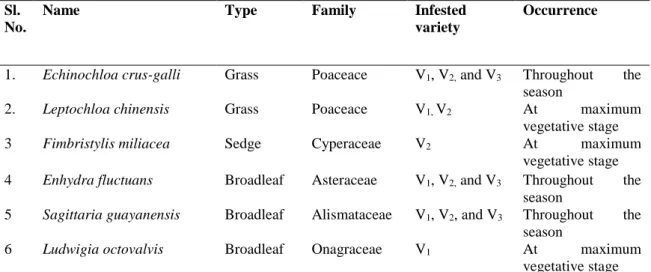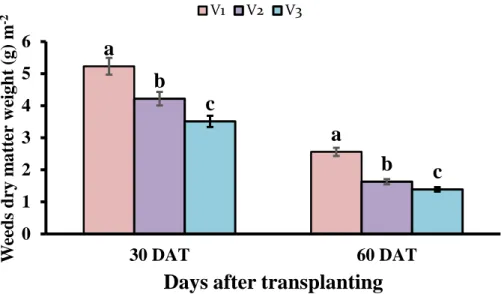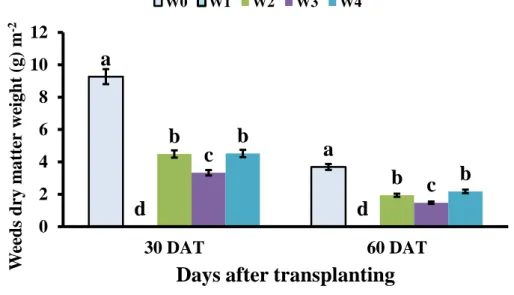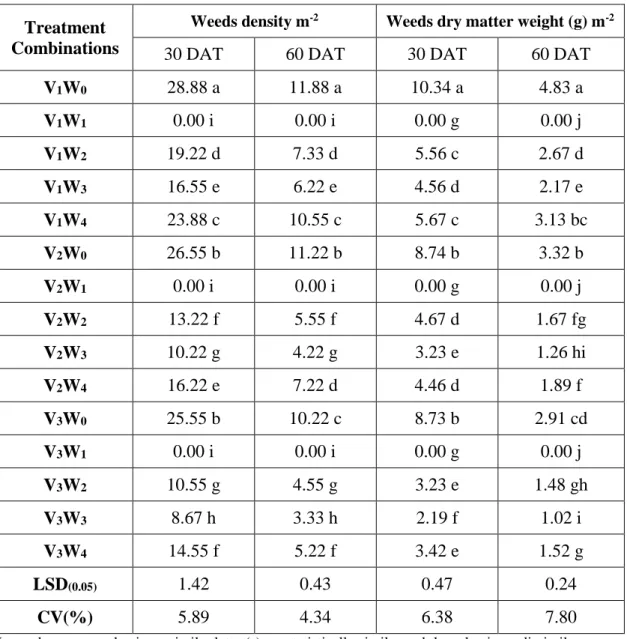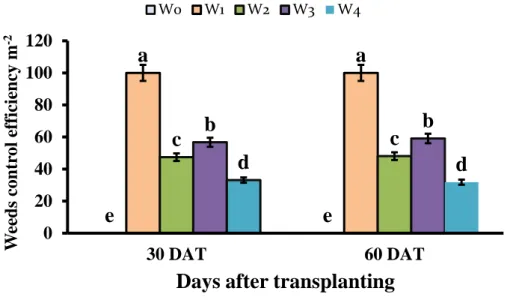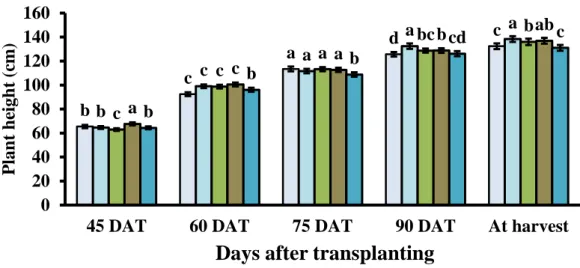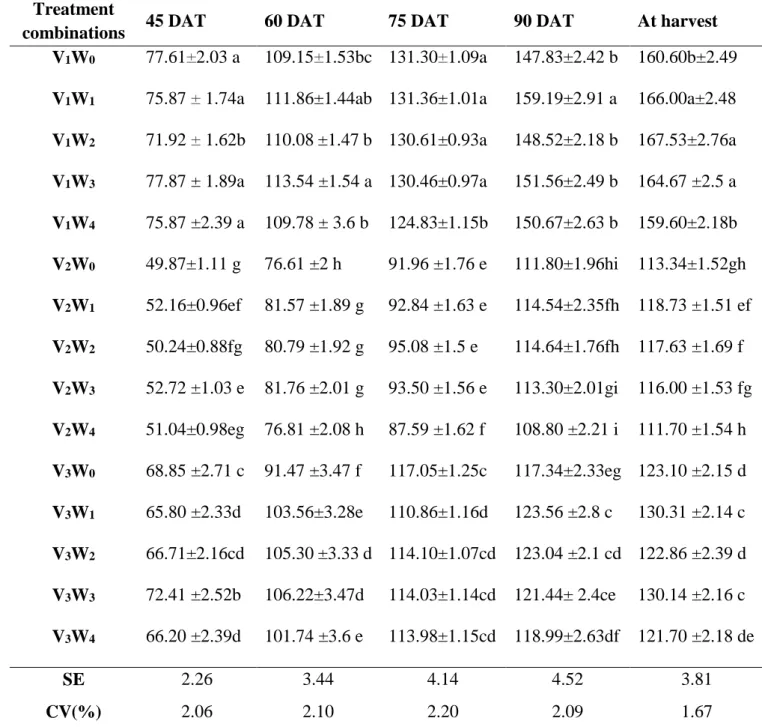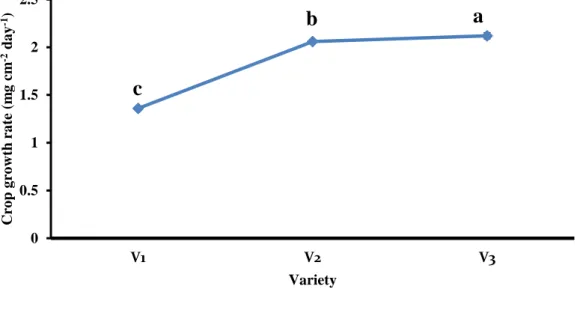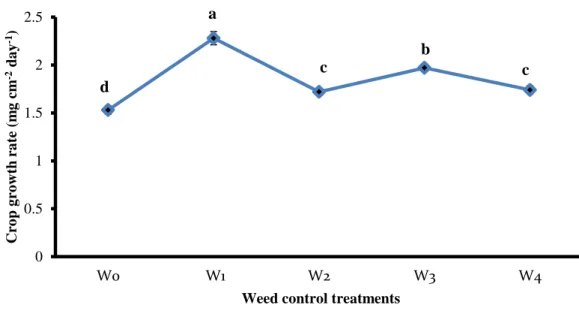COMPETITIVE EFFECT OF FREE FLOATING PLANTS ON WEED CONTROL, GROWTH AND YIELD OF TRANSPLANTED AMAN RICE
MD. TANVIR WAHID
DEPARTMENT OF AGRONOMY
SHER-E-BANGLA AGRICULTURAL UNIVERSITY DHAKA-1207
JUNE, 2021
COMPETITIVE EFFECT OF FREE FLOATING PLANTS ON WEED CONTROL, GROWTH AND YIELD OF TRANSPLANTED AMAN RICE
BY
MD. TANVIR WAHID REGISTRATION NO: 14-05852
A Thesis
Submitted to the Faculty of Agriculture, Sher-e-Bangla Agricultural University, Dhaka,
in partial fulfillment of the requirements for the degree of
MASTER OF SCIENCE (M.S.) IN
AGRONOMY
SEMESTER: JANUARY- JUNE, 2021 Approved by:
Dr. Sheikh Muhammad Masum Supervisor
Prof. Dr. Hazrat Ali Co-Supervisor
Prof. Dr. Tuhin Suvra Roy Chairman
Examination Committee
DEPARTMENT OF AGRONOMY Sher-e-Bangla Agricultural University
Sher-e-Bangla Nagar Dhaka-1207 CERTIFICATE
This is to certify that thesis entitled, “COMPETITIVE EFFECT OF FREE FLOATING PLANTS ON WEED CONTROL, GROWTH AND YIELD OF TRANSPLANTED AMAN RICE” submitted to the Faculty of Agriculture, Sher-e-Bangla Agricultural University, Dhaka, in partial fulfilment of the requirements for the degree of MASTER OF SCIENCE (M.S.) in AGRONOMY, embodies the result of a piece of bona-fide research work carried out by MD. TANVIR WAHID, Registration no. 14-05852 under my supervision and guidance. No part of the thesis has been submitted for any other degree or diploma.
I further certify that such help or source of information, as has been availed of during the course of this investigation has duly been acknowledged.
Date:
Place: Dhaka, Bangladesh
Dr. Sheikh Muhammad Masum Department of Agronomy Sher-e-Bangla Agricultural University,
Dhaka-1207
DEDICATED TO MY
BELOVED PARENTS
i
ACKNOWLEDGEMENTS
All praises to the Almighty Allah, the great, the gracious, merciful and supreme ruler of the universe who enables me to complete this present piece of work for the degree of Master of Science (M.S.) in the Department of Agronomy.
The author would like to express his deepest sense of gratitude, respect to his research supervisor, Dr. Sheikh Muhammad Masum, Department of Agronomy, Sher- e- Bangla Agricultural University, for his kind and scholastic guidance, untiring effort, valuable suggestions, inspiration, extending generous help and encouragement during the research work and guidance in preparation of manuscript of the thesis.
The author sincerely expresses his deepest respect and boundless gratitude to his co- supervisor Prof. Dr. Hazrat Ali, Vice chancellor, First Capital University of Bangladesh, for his helpful suggestion and valuable advice during the preparation of this manuscript.
It is highly appreciating words for Prof. Dr. Tuhin Suvra Roy Chairman, Department of Agronomy, Sher-e-Bangla Agricultural University, for the facilities provided, in carrying out this work. The author also acknowledges with deep regards the help and cooperation received from his respected teachers and stuff of the Department of Agronomy, Sher-e-Bangla Agricultural University while carrying out this work.
The author feels proud to express his sincere appreciation and gratitude to Ministry of Science and Technology, The People’s Republic of Bangladesh for awarding him National Science and Technology (NST) fellowship.
At last but not the least, the author feels indebtedness to his beloved parents and brother whose sacrifice, inspiration, encouragement and continuous blessing paved the way to his higher education and reach at this stage. May Allah bless us.
The Author
ii
COMPETITIVE EFFECT OF FREE FLOATING PLANTS ON WEED CONTROL, GROWTH AND YIELD OF TRANSPLANTED AMAN RICE
VARIETIES ABSTRACT
A study was conducted to find out the suppressing ability of floating weeds in T. aman rice (Oryza sativa L.) at the Agronomy field of Sher-e-Bangla Agricultural University, Dhaka, Bangladesh from July 2019 to December 2019. The experiment consisted of two factors viz. rice varieties (3) i.e. Tulshimala, BR11(Mukta) and BRRI hybrid dhan6, and weed management (4) i.e. weedy check (control), Integrated Weed Management (one pre-emergence herbicide Pretilachlor 6% + pyrazosulfuron 0.15%
and one hand weeding), spreading of Water Lettuce (Pistia stratiotes), Duckweed (Lemna minor) and Kariba weed (Salvinia molesta) in 0.5 m2 area. The experiment was laid out in a split-plot design with three replications. The ranking of the relative rate of spreading (RRS) over the experiment L. minor > S. molesta > P. stratiotes. A total of 6 weed species representing 5 families were found from the transplanting to the later stage of rice growth where the occurrence of weed infestation related to rice variety and crop growth. BRRI hybrid dhan6 significantly suppressed weeds in related plots. Integrated weed management successfully control all weeds and gave the highest weed control efficiency and weed control index. Although weed biomass significantly reduced, the morphological and biomass characteristics of T. aman rice varieties got disadvantages when grown with P. stratiotes and S. molesta. Cultivation of BRRI hybrid dhan6 along with weed control through integrated weed management gave the highest grain yield (5.92 t ha-1) and the highest economic return comparable to other treatment combinations. However, the spreading of L. minor facilitated optimal weed control and good yields were harvested without significant differences and as well as net return irrespective of varieties. Therefore, weed competitive variety should be considered along with the spreading of L. minor to reduce herbicide loads in the environment and to the evolution of cross-resistant weed populations.
iii
LIST OF CONTENTS
CHAPTER TITLE PAGE NO.
ACKNOWLEDGEMENTS i
ABSTRACT ii
LIST OF CONTENTS iii
LIST OF TABLES vii
LIST OF FIGURES viii
LIST OF APPENDICES xi
LIST OF PLATES xiii
LISTS OF ACRONYMS xiv
I INTRODUCTION 1
II REVIEW OF LITERATURE 5
2.1 Weed flora of aman rice 5
2.2 Weed competition in rice 6
2.3 Effect of competitive rice variety on weeds 6 2.4 Effect of weed management on rice growth
characters
7
2.5 Effect of rice varieties on yield contributing characters
8
2.6 Effect on yield performance of rice varieties 10 2.7 Impact of aquatic free-floating weeds on rice 11
2.8 Integrated weed management in rice 13
2.9 Effect of weed control method on the economics of rice
14
III MATERIALS AND METHODS 15
3.1 Location of the experimental site 15
3.2 Experimental Duration 15
iv
LIST OF CONTENTS (Cont’d)
CHAPTER TITLE PAGE NO.
3.3 Soil Characteristics of the experimental field 15 3.4 Climate condition of the experimental field 16
3.5 Planting material 16
3.6 Description of the rice varieties 16
3.7 Description of the herbicides and free-floating aquatic plants used for weeds control in the experimental field
17
3.8 Seed collection and sprouting 21
3.9 Raising of the T. aman seedlings 21
3.10 Preparation of experimental field 21
3.11 Fertilizer management 21
3.12 Field operation 22
3.13 Experimental treatments 23
3.14 Experimental design and layout 23
3.15 Intercultural operations 23
3.16 Data collection 25
3.17 Relations 26
3.18 Procedure of recording data 26
3.19 Economic analysis of rice cultivation 32
3.20 Data analysis technique 33
IV RESULTS AND DISCUSSION 34
4.1 Weed Parameters 34
v
LIST OF CONTENTS (Cont’d)
CHAPTER TITLE PAGE NO.
4.1.1 Relative rate of spread (RRS) 34
4.1.2 Weed flora of T. aman rice 35
4.1.3 Weed density m-2 36
4.1.4 Weed dry weight m-2 (g) 38
4.1.5 Weed control efficiency (%) 41
4.1.6 Weed control index (%) 44
4.2 Crop growth parameters 47
4.2.1 Plant height (cm) 47
4.2.2 Number of tillers hill-1 51
4.2.3 Leaf area index 54
4.2.4 Dry matter accumulation 57
4.2.5 Crop growth rate 62
4.2.6 Relative crop growth rate 63
4.2.7 Net assimilation rate 65
4.3 Yield contributing characters 69
4.3.1 Number of effective tillers hill-1 69
4.3.2 Number of non-effective tillers hill-1 70
4.3.3 Length of panicle (cm) 70
4.3.4 Number of filled grains panicle-1 72
4.3.5 Number of unfilled grains panicle-1 73
4.3.6 Number of total grains panicle-1 73
vi
LIST OF CONTENTS (Cont’d)
CHAPTER TITLE PAGE NO.
4.3.7 4.6.6 1000-grain weight (g) 74
4.4 Yield characters 78
4.4.1 Grain yield (t ha-1) 78
4.4.2 Straw yield (t ha-1) 80
4.4.3 Biological yield (t ha-1) 82
4.4.4 Harvest index (%) 84
4.5 Relationship of grain yield and leaf area index
(LAI) and total dry matter production 88 4.6 Correlation of grain yield with panicle length, grains
panicle-1 and 1000-grain weight 89
4.7 Economic viability of different treatments
combination 91
4.7.1 Total cost of production 91
4.7.2 Gross return (Tk.) 91
4.7.3 Net return (Tk.) 92
4.7.4 Benefit cost ratio (BCR) 92
V SUMMARY AND CONCLUSION 94
REFERENCES 101
APPENDICES 115
PLATES 126
vii
LIST OF TABLES
Table No. TITLE Page
No.
1 List of infesting weeds in the experimental field of T.
aman rice at Sher-e-Bangla Agricultural University, Bangladesh
35
2 Combined effect of variety and weed control treatments on weeds density and dry matter weight (g) m-2 of T.
aman rice
41
3 Combined effect of variety and weed control treatments on weeds control efficiency and index m-2 of T. aman rice
47
4 Combined effect of variety and weed control treatments on plant height of aman rice at different DAT
50 5 Combined effect of variety and weed control treatments
on number of tillers hill-1 of aman rice at different days after transplanting
54
6 Combined effect of variety and weed control treatments on leaf area index of T. aman rice at different days after transplanting
57
7 Combined effect of variety and weed control treatments on dry matter weight hill-1 of T. aman rice at different days after transplanting
61
8 Combined effect of variety and weed control treatments on the crop growth rate, relative crop growth rate, and net assimilation rate of T. aman rice
68
9 Effect of individual treatment on the yield contributing characters of aman rice
76 10 Combined effect of variety and weed control treatments
on yield contributing characters of aman rice
77
11
Combined effect of variety and weed control treatments on grain, straw, biological yield (t ha-1) and harvest index (%) of T. aman rice
87 12 Cost of production, return and Benefit cost ratio (BCR)
of transplanted T. aman rice varieties under different weed control treatments
93
viii
LIST OF FIGURES Figure
No. TITLE Page
No.
1 Relative rate of spread of floating weeds in T. aman rice varieties
34 2 Effect of rice variety on weed density m-2 of T. aman rice at
different days after transplanting.
36 3 Effect of weed control treatments on weed density m-2 of T.
aman rice at different days after transplanting.
37 4 Effect of variety on weed dry weight m-2 of T. aman rice at
different days after transplanting.
39 5 Effect of weed control treatments on weed dry weight m-2 of
T. aman rice at different days after transplanting.
40 6 Effect of variety on weed control efficiency m-2 of T. aman
rice at different days after transplanting.
42 7 Effect of weed control treatments on weed control efficiency
m-2 of T. aman rice at different days after transplanting.
43 8 Effect of variety on weed control index m-2 of T. aman rice
at different days after transplanting.
44 9 Effect of weed control treatments on weed control index
m-2 of T. aman rice at different days after transplanting.
46 10 Effect of variety on plant height of T. aman rice at different
days after transplanting
48 11 Effect of weed control treatments on plant height of T.
aman rice at different days after transplanting
49 12 Effect of variety on number of tillers hill-1 of T. aman rice at
different days after transplanting.
51
ix
LIST OF FIGURES (Cont’d) Figure
No. TITLE Page
No.
13 Effect of weed control treatments on number of tillers hill-1 of T. aman rice at different days after transplanting.
52 14 Effect of variety on leaf area index of T. aman rice at
different days after transplanting.
55 15 Effect of weed control treatments on leaf area index of T.
aman rice at different days after transplanting.
56 16 Effect of variety on dry matter accumulation hill-1 of T. aman
rice at different days after transplanting
58
17 Effect of weed control treatments on dry matter
accumulation hill-1 of T. aman rice at different days after transplanting.
59
18 Effect of variety on the crop growth rate of T. aman rice. 62 19 Effect of weed control treatments on the crop growth rate of
T. aman rice.
63
20 Effect of variety on the relative crop growth rate of T. aman rice.
64
21 Effect of weed control treatments on the relative crop growth rate of T. aman rice.
65
22 Effect of variety on net assimilation rate of T. aman rice. 66 23 Effect of weed control treatments on net assimilation rate of
T. aman rice.
67
24 Effect of variety on grain yield of T. aman rice. 78
x
LIST OF FIGURES (Cont’d) Figure
No. TITLE Page
No.
25 Effect of weeds control treatments on grain yield of aman rice.
79
26 Effect of variety on straw yield of T. aman rice. 81 27 Effect of weeds control treatments on straw yield of T. aman
rice.
82
28 Effect of variety on biological yield of T. aman rice. 83 29 Effect of weeds control treatments on biological yield of
aman rice.
84
30 Effect of variety on harvest index of T. aman rice. 85 31 Effect of weeds control treatments on harvest index of T.
aman rice.
86
32 Relationship between leaf area index (LAI) and total dry matter production of T. aman rice.
88
33 Relationship between leaf area index (LAI) and grain yield of T. aman rice.
89
34 Relationship between panicle length and grain yield of T.
aman rice.
90
35 Relationship between total grains panicle-1 and grain yield of T. aman rice.
90
36 Relationship between 1000-grain weight and grain yield of T. aman rice
91
xi
LIST OF APPENDICES LIST OF
APPENDICES TITLE Page
No.
Appendix I. Map showing the experimental location under study 116 Appendix II Soil characteristics of the experimental field 117 Appendix III. Monthly meteorological information during the period
from October, 2019 to February 2020
118
Appendix IV. Layout of the experimental field 119 Appendix V. Analysis of variance of the data of weed density (m-2)
and weed dry weight (gm-2) at 30 and 60 DAT
120 Appendix VI. Analysis of variance of the data of weed control
efficiency (%) and weed control index (%) at 30 and 60 DAT
120
Appendix VII. Analysis of variance of the data of plant height of T.
aman rice at different DAT
121 Appendix VIII. Analysis of variance of the data of number of tillers
hill-1 of T. aman rice at different DAT
121 Appendix IX. Analysis of variance of the data of leaf area index of T.
aman rice at different DAT
122 Appendix X. Analysis of variance of the data of dry matter
accumulation plant-1 of T. aman rice at different DAT
122 Appendix XI. Analysis of variance of the data of crop growth rate,
relative crop growth rate and net assimilation rate of T.
aman rice
122
Appendix XII. Analysis of variance of the data of Effective tillers hill-1 , non-effective tillers hill-1 and Panicle length of T. aman rice.
123
Appendix XIII. Analysis of variance of the data of filled, unfilled, total grains panicle-1 and 1000 grains weight of T. aman rice
123
xii
LIST OF APPENDICES (Cont’d) LIST OF
APPENDICES TITLE Page
No.
Appendix XIV Analysis of variance of the data of on grain, straw, biological yield and harvest index of T. aman rice
123 Appendix XV Wages and price of different items used in the
experiment
124 Appendix XVI Total cost of production of T. aman rice varieties
cultivations
125 Appendix XVII
Gross return from T. aman rice cultivation 126
xiii
LIST OF PLATES
PLATES TITLE Page
No.
1 Transplanting aman rice to research field 127 2 Spreading of Salvinia molesta in research plot 127 3 Spreading of pistia stratiotes in research plot 127 4 Spreading of Lemna minor in research plot 128
5 Infestation of weed in research plot 128
xiv
LIST OF ACRONYMS
AEZ Agro-Ecological Zone
BARI Bangladesh Agricultural Research Institute
BAU Bangladesh Agricultural University
BBS Bangladesh Bureau of Statistics
CV% Percentage of coefficient of variance
cv. Cultivar
DAE Department of Agricultural Extension
DAT Days after transplanting
0C Degree Celsius
et al And others
FAO Food and Agriculture Organization
g gram(s)
ha-1 Per hectare
HI Harvest Index
i.e. That is
kg Kilogram
Max Maximum
mg Milligram
Min Minimum
MoP Muriate of Potash
N Nitrogen
No. Number
NS Not significant
% Percent
SAU Sher-e-Bangla Agricultural University
SRDI Soil Resources and Development Institute
t Ton
TSP Triple Super Phosphate
Wt. Weight
1 CHAPTER I INTRODUCTION
Agrarian country Bangladesh is enriched with plenty of water as well as suitable climatic condition for rice production. The annual production of rice in Bangladesh is 35.30 million metric tons from 11.80 million acres of land (BBS, 2019). In Bangladesh, among three rice ecotypes namely aus, aman, and boro aman rice occupies the highest area coverage (Magzter, 2021). Total area coverage by aman rice of the financial year 2020-21 has been estimated at 5625907 hecters compared to 5559964 hecters of the financial year 2019-20 which is 0.87 % higher (BBS, 2022).
The growth process of rice plants under different agro-climatic conditions differs due to the specific rice variety (Alam et al., 2012). Variety itself is a genetic factor, which contributes a lot to produce the yield components and yield of a particular crop.
Compared with conventional varieties, the high-yielding varieties have larger panicles resulting in an average increase of rice grain is 7.27% (Bhuiyan et al., 2014). BRRI (1991) reported that modern transplant aman rice varieties produced grain yield up to 6.5 t ha-1. Therefore, varietal performance is an important factor for improving crop production.
Weeds are an integral part of agricultural systems which significantly reduce farmer’s profitability (Ahmed et al., 2014). Weeds compete with crop plants for light, nutrients, water, and space. In Bangladesh, the climate and edaphic conditions are highly favorable for weed growth (Ahmed et al., 2014). This can lead to significant yield losses without adequate weed management. In the absence of weed control, rice yield losses due to weeds ranged from 15% to 40% in transplanted rice, and 40% to 100% in direct- seeded rice (Rashid et al., 2012; Ahmed and Chauhan, 2014). However, the level of yield loss depends not only on the infestation, but also on the composition of weed flora. Farmers spend a lot of resources to reduce their impact, many a times quite unsuccessfully. Thus, the control of weeds in rice paddy fields is crucial for optimum production.
The types of weed management practices employed can directly influence the weed control cost and farm income. Herbicide-based weed control is consequently becoming more popular, as it can reduce overall costs by minimizing costly labor (Islam et al.
2
2017). In the last three decades, the use of herbicides in Bangladesh has increased 37- fold (BBS 2017). Yet although herbicides can effectively control rice weeds, sole dependence on chemical control measures poses both environmental and economic risks (Kumar et al., 2017). The former include the evolution of herbicide resistance in weeds and negative effects on non-target organisms, whereas the latter include additional costs involved in controlling new weed species that may result from shifts in weed flora with the use of chemical control methods (Hossain et al., 2020; Heap, 2021).
As the herbicides are active substances, there are concerns about their effects on non- target organisms. Herbicide-resistant weeds and associated chemical pollution are serious environmental concerns. Prevention of the overuse of herbicides in rice paddy fields and the development of an alternative method without harming the agroecosystem are emerging issues. These factors permit integrated approaches to manage weeds while reducing the environmental hazards associated with herbicides, and high costs associated with manual weeding (Juraimi et al., 2013; Chauhan et al., 2015). Estimates indicate that farmers spend about US$100 to 300 ha–1, which is about 10 % to 20 % of the total production cost for controlling weeds in rice fields (Islam et al., 2017). Hence, integrated weed management (IWM) could be an effective strategy to reduce weed control costs, reduce the yield gap, and increase yield and profits from rice production.
Integrated weed management can be defined as the integration of more than one approach involving cultural, physical, biological, and chemical methods (Harker and Donovan, 2013). It consists of both chemical and nonchemical approaches and focuses on keeping weed populations below a certain threshold level by optimizing control measures strategically and holistically (Wilkerson et al., 2002).
Herbicides are used as a last resort in IWM, although where they are required, they should be used in an integrated management approach, such as integration of soil-active pre-emergence and post-emergence herbicides, rotation of herbicides with different modes of action (MOAs), or mixing of herbicides with different MOAs with best application practices (Harker et al., 2012; Harker and Donovan, 2013; Kumar et al., 2017). Different pre-mix and tank-mix combinations are being tried out to control mixed weeds in one go (Yadav et al., 2008) which will not only reduce the total volume of herbicide but also ease and economize its application. Some herbicides were reported
3
to have not only controlled weeds but also increased the yield of the different rice varieties.
Small, floating, aquatic plants are often a conspicuous component of aquatic systems (Hillman, 1961). It can be either competitive with rice fields or suppressive of weeds without accumulation of nutrients from the field. The ability of Azolla to suppress other weeds has been mentioned in Philippino literature studies since 1927 (Moody and Janiya, 1992). Weed growth is suppressed when Azolla forms a thick, virtually light- proof mat. There are probably two mechanisms for this suppression, the most effective being the light-starvation of young weed seedlings by the blockage of sunlight (Lumpkin and Plucknett 1980). The other mechanism is the physical resistance to weed seedling emergence created by a heavy, interlocking Azolla mat, which does not affect the growth of rice (Pons, 1987). Bangun and Syam (1988) showed that an Azolla cover could significantly reduce weed infestation without harming the rice yield. Several studies have reported the suppressive effect of Azolla on rice weed species, such as Utricularia flexuosa Vanl, Echinochloa crus- galli (L.) Beauv., Sagittaria spp., Cyperus difformis L. and Polygonum sp. (Nguyen 1930; Ngo 1973; Talley et al..1977).
Pistia stratiotes is a perennial aquatic macrophyte widely distributed throughout the world and is capable of removing several heavy metals from water, including Arsenic (Farnese et al., 2014). Aquatic floating plant-like duckweed (Lemna minor) is mainly used on phytoremediation and nutrient recovery from wastewater and for animal feedstock and the production of biofuels, due to its high growth rate, high biomass yield, excellent nutrient uptake ability, and tolerance to high nutrient levels (Cheng et al., 2002; Mohedano et al., 2012). In transplanted rice, S. molesta was found to cause a 12.5% yield loss due to a reduction in panicle-bearing tillers (Azmi, 1988). Excessive growth of the free-floating plant causes a negative effect on the growth and development of the standing crop. Dense mats of the free-floating plant harm wetland rice ecosystems because they create anoxic conditions that strongly reduce plant diversity (Jansen et al., 1998). Invasions by introduced exotic species are partly responsible for the increase of floating plant dominance. However, eutrophication is likely to have boosted the spread of free-floating plants, too.
In Bangladesh, few studies have been conducted to find out the competitive effect of free-floating plants on weed control, growth, and yield of aman rice varieties. Research work on the combined effect of T. aman varieties and weed control (through herbicide
4
and free-floating plants) is limited. Considering the above facts the present study was undertaken with the following objectives:
i. To identify weed flora to be present in transplanted aman rice under study.
ii. To evaluate the performance of transplanted aman rice varieties under the conditioned designed.
iii. To explore the spreading pattern of free-floating plants and its effect on agronomic features of rice varieties under study.
iv. To evaluate the competitive effects of free floating plants on weed control, growth and yield of rice varieties chosen for the study.
v. To find out the profitability of cropping the rice varieties through economic analysis with ongoing market prices of the products.
5 CHAPTER II
REVIEW OF LITERATURE
Weed infestation is a major constraint in rice cultivation and accounts for 45-51% yield losses in rice. Weed control through the sequential application of pre and post- emergence herbicides, especially with those of low-dose high-efficiency herbicides is highly recommended. But persistent herbicides can remain active in the environment for long periods, potentially causing soil and water contamination and adverse effects to non-target organisms. Application of biological control agents like aquatic macrophytes will positively or negatively impact weed and concerning weed dynamics in transplanted rice. In awareness of the above, an attempt was made in this section to collect and study relevant information available regarding the competitive effect of free-floating plants on weed control, growth, and yield of aman rice varieties in the country and abroad to gather knowledge helpful in conducting the present piece of work and subsequently writing up the result and discussion.
2.1 Weed flora of aman rice
Duary et al. (2015) noticed that when the water level was more than 2.5 cm, Sphenoclea zeylanica, Monochoria vaginalis, Ammania baccifera and Hydrolea zeylanica were the most predominant weeds.
In rainfed lowland rice, Malik et al. (2014) recorded Echinochloa crus-galli and Paspalum scorbiculatum among annual grasses, Cyperus iria, C. difformis, and Fimbristylis miliacea among sedges and Sphenoclea zeylanica and Monochoria vaginalis among broadleaf weeds as dominant weeds.
Acharya and Battacharya (2013) reported that under unweeded situations sedges constituted 38 percent of the weed population followed by broadleaf weeds (34 %) and grasses (28 %). Duary and Mukherjee (2013) reported that the Incidence of Ludwigia parviflora was observed with the highest frequency in lowland rice. The probable reason for its wide ecological amplitude might be the adaptation by special structures like pneumatophores. According to Sridevi et al. (2013), in shallow depths of water, the dominant grass species noted were E. crus-galli and E. colona and sedges were C.
iria, C. rotundus, and F. miliacea and broad-leaved weed species were Ammania baccifera, Marsilea quadrifolia, and Potamogeton distinctus.
6
Monika et al. (2012) observed E. crus-galli as the dominant weed comprising 32.8 percent of the total weed population at the most critical period (25 DAT), while M.
vaginalis was dominant at the harvest stage (18.8 %) in Kharif season.
Ravisankar et al. (2008) found that wet seeded rice grasses constituted 51.5 percent of the total weed population followed by sedges (30.9 %).
According to Mahajan et al. (2006), under a direct seeding system, the major weeds were E. crus-galli and E. colona among grasses, C. difformis, and C. iria among sedges, Trianthema portulacastrum and Eclipta alba among broadleaf weeds.
2.2 Weed competition in rice
Hassan and Upasani (2015) reported that weeds were the main problem of wetland rice as pre-germinated seeds and weed seeds in soil seed bank grew simultaneously thereby inviting competition for resources like moisture, nutrient, and light.
Mandal et al. (2013) found that every year weeds caused yield loss from 15 to 76 percent in rice crops among grasses, sedges, and broadleaf weeds, grasses are reported to be the heavy competitors to crop. Rao and Nagamani (2013) reported that weeds were one among the most important biological constraint to increasing crop yield, acting at the same trophic level as the crop, weeds exploited a major share of the available resources for plant growth and thus hindered the attainment of maximum rice productivity.
According to Maity and Mukherjee (2008), uncontrolled weeds decreased rice yield by 96 percent in dry direct-seeded rice and 61 percent in wet direct-seeded rice systems.
2.3 Effect of competitive rice variety on weeds
Sohel et al. (2020) that the competitive ability of different rice varieties significantly reduces the weed population in the field which ultimately impacts the total dry matter accumulation by weed in m-2 area. Salam et al. (2020) observed that cultivars of rice influenced weed densities at different DATs.
Shawon et al. (2018) reported that the number of weeds was lower in the hybrid cultivated plots might be due to vigorous growth of the cultivar helped to reduce the weed population and hence lower in number.
7
Afrin et al. (2015) reported that the variety of rice significantly influenced the weed population, total weed dry weight, and weed control efficiency at various days after transplanting (DAT). The number of weeds or the weed population depends on the soil, environment, varieties, and other factors. As a result, variations in the weed population occurred.
Chauhan and Johnson (2011) reported that the high competitive cultivars would be rapid canopy closure so that shade under the canopy would suppress the growth of weeds resulting in a higher weed control index. Hybrids usually have better vigor than inbreeds; therefore, when possible, hybrids can also be used. They also reported that the weed control index could be attributed to less weed biomass observed due to their ability to suppress weeds.
2.4 Effect of weed management on rice growth characters
Salam et al. (2020) experimented to evaluate the effect of weed management practices on the performance of rice cultivars and reported that plant height was significantly influenced by cultivars.
Mahmud et al. (2017) experimented to investigate the response of some short-duration aman rice varieties to date of transplanting. The experimental result showed that plant height was significantly influenced by rice varieties and among them, BRRI dhan56 produced the tallest plant of 128.53 cm. BRRI dhan57 produced the shortest plant of 110.04 cm which is statistically similar to Binadhan-7 (110.51 cm).
Tyeb et al. (2013) reported that the variation in plant height is due to the effect of varietal differences. The variation of plant height is probably due to the genetic make- up of the cultivars.
Paul et al. (2019) undertook a study to detect short-statured rice plants with aromatic and long to medium slender grain where twelve advanced rice lines (derived from the local rice germplasm) with a local check Kataribhog were evaluated. Experiment rest showed that the highest total tiller numbers hill-1at harvest was observed in the local aromatic rice genotype SAU ADL10 (18.75) whereas the minimum tiller numbers hill-
1 (6.58) was obtained from SAU ADL12.
8
Nahida et al. (2013) reported that rice cultivars varied considerably in terms of crop growth characteristics as well as yield and yield contributing characters. Experimental results revealed that dry matter (DM) accumulation over time varied considerably due to variety. Among different Days After Transplanting (DAT), Kachra produced the highest dry matter (1420.7 g m-2) and Kalijira produced the lowest dry matter (1105.7 g m-2 ) at 92 DAT. They also reported that the difference in effective tillers hill-1 is the genetic makeup of the variety, which is primarily influenced by heredity.
Mia and Shamsuddin (2011) conducted a field experiment to determine the physio morphological attributes concerning yield potential of modern and aromatic rice varieties and reported that the CGR is the product of LAI and NAR values, and higher CGR achieved in the modern varieties than the aromatic varieties may be due to the higher LAI.
Toshiyuki et al. (2006) reported that the genotypic difference in grain yield was most closely related to that in crop growth rate.
Hossain et al. (2005) found variation among the evaluated native aromatic rice cultivars in the case of fertile tillers hill-1 which ranged from 8.6 to 11.4.
2.5 Effect of rice varieties on yield contributing characters
Akter et al. (2020) reported that the number of non-effective tiller hill-1 was significantly influenced due to different varieties. The maximum non effective tillers hill-1(10.90) was observed in Chiniatap-2 which was statistically differed from all other varieties. The lowest non-effective tillers hill-1 (2.33) was obtained from Badshabhog which was statistically similar with BRRI dhan38. Akondo et al. (2020) conducted a field experiment with six rice varieties to determine their growth and yield performance and found that all the growth and yield contributing attributes varied significantly among the six rice varieties. The results revealed that among the varieties Binadhan-16 had a significantly maximum number of filled spikelets/panicle (108.43) whereas a minimum number of filled spikelets/panicle (60.60) was observed in Binadhan-11 which was statistically identical to Binadhan-15 (63.87 cm). Variation in grain filling may have occurred due to genetic, environmental, or cultural management practices adopted. Khatun et al. (2020) reported that the maximum 1000-grain weight was observed in Binadhan-17 (27.25 g) that was statistically similar to Binadhan-11 (26.45
9
g) and Binadhan- 16 (26.88 g). The minimum 1000-grain weight observed in Binadhan- 7 (21.94 g) was statistically different from other varieties. Latif et al. (2020) reported that 1000-grain weight was significantly different due to the varietal performance. The highest 1000-grain weight (26.33 g) was obtained in BR14 than BRRI dhan28 (22.60 g) and BRRI dhan29 (22.43 g).
Paul et al. (2019) observed the maximum panicle length (32.63 cm) was recorded in genotype SAU ADL10 genotype and the minimum panicle length of 26.33 cm was recorded in the SAU AD7 genotype.
Hossain et al. (2016) shown that different rice varieties and nutrient levels along with their interaction have a significant effect on the growth and yield of rice. It was observed that the panicle length of the crop was influenced by variety. Binadhan-10 produced a longer panicle (24.60 cm) compared to BRRI dhan28 (20.97 cm).
Chamely et al. (2015) reported that the longest panicle (23.19 cm) was found in the variety BRRI dhan29 and the smallest one was observed in BRRI dhan45. The variation as assessed might be due to genetic characters of the varieties primarily influenced by the heredity.
Jisan et al. (2014) carried out a study to examine the yield performance of some transplant aman rice varieties and showed that among different rice varieties BRRI dhan52 produced the highest number of total spikelets panicle1 (155.20) and the lowest number of total spikelets panicle-1 (118.80) was obtained from BRRI dhan57.Roy et al. (2014) reported that the number of spikelets per panicle in indigenous rice is generally lower compared to high-yielding varieties.They also found the difference in thousand grains weight due to morphological and varietal variation. Sarkar (2014) reported that the number of filled grains/panicles was influenced significantly due to variety.
Aminpanah et al. (2013) showed that there was a significant difference among rice varieties and lines under both weedy and weed-free conditions for 1000-grain weight.
Under weed-free conditions, Nemat and Khazar had the highest and lowest (31.8 and 25.87 gram, respectively) of 1000-grain weight. But, under weedy conditions, Nemat with 30.7 gram and line 842 with 24.3 gram had the highest and lowest 1000-grain weight, respectively. Mahamud et al. (2013) reported that the variation in filled grains panicle–1 was recorded due to genotypic differences of varieties. Nahida et al. (2013)
10
reported that among the undesirable traits, the number of unfilled grains panicle-1 was an important one and played a vital role in yield reduction. The effect of variety on the number of unfilled grains panicle-1 was highly significant. Morichsail produced the lowest number of unfilled grains panicle-1 (11.17) which contributed the highest grain yield of that variety. This variation in the number of unfilled grains panicle-1 might be due to the genetic characteristics of the varieties.
Sohel et al. (2009) reported that differences in spikelets sterility varied significantly by variety and plant spacing.
Diaz et al. (2000) also reported that panicle length varied among varieties.
2.6 Effect on yield performance of rice varieties
Chowhan et al. (2019) found significant differences in harvest index among different rice varieties. From their experiment, they concluded that varieties Shakti-2 (V4), Heera-1 (V3), and BRRI dhan28 (V1) had an identical harvest index of 50.9%, 48.5%, and 47.9 respectively. Only Bina dhan-14 (V2) produced the harvest index (40.0%). It appears that hybrid rice maintained a higher harvest index.
Shawon et al. (2018) reported that among different rice varieties the highest grain yield (4.04 t ha-1) was recorded in the hybrid variety Aloron. It might be the resultant effects of the highest tillers hill-1 and grains panicle-1 of those cultivars. Whereas the lowest grain yield (1.07 t ha-1) was recorded in cultivar Doom which was at par with the variety BRRI dhan43 (1.32 t ha-1).
Howlader et al. (2017) found that among the genotypes Moulata showed the highest biological yield (9.657 t ha–1). Mahmud et al. (2017) experimented to investigate the response of some short duration aman rice varieties to date of transplanting and reported that among rice varieties the highest straw yield (5.67t ha–1) is produced by BRRIdhan49 whereas the lowest (3.96 t ha–1) straw yield was produced by BRRI dhan57. Rahman et al. (2017) reported that the highest harvest index was found in BRRI dhan59 (42.78%) and the lowest one was found in BRRI dhan28 (40.73%).
11
Ferdous et al. (2016) found that the highest grain yield was obtained from the interaction of BRRI dhan39 × weed-free condition which was statistically identical (5.50 t ha-1) with the interaction of variety BR11 × two hand weedings at 15 and 35 DAT.
Hossain et al. (2014) found that the variation in biological yield was also found due to the variation in grain and straw yield.
Islam et al. (2013) reported that the varieties which produced a higher number of effective tillers hill–1 and higher number of filled grains panicle–1 also showed higher grain yield ha–1.
Tyeb et al. (2013) reported that the variation in straw yield is due to the effect of varietal differences.
Uddin et al. (2011) reported that the harvest index differed significantly among the varieties due to its genetic variability.
Dutta (2002) reported that the genotypes, which produced a higher number of effective tillers per hill and a higher number of grains per panicle also showed higher grain yield in rice.
Shah et al. (1991) reported that variety had a great influence on the harvest index.
2.7 Impact of aquatic free-floating weeds on rice
Pulido (2016) reported that duckweeds may be viable sources of organic fertilizer, particularly supplying nitrogen (N) and phosphorus (P) to plants.
Wang et al. (2015) reported that in addition to enhancing rice production, duckweed may also suppress rice diseases, reduce the greenhouse gas footprint associated with rice cultivation and remediate heavy metal contaminants in paddy fields.
Hussner et al. (2014) reported that the dense mats of Pistia stratiotes block sunlight which limits the growth of submerged plant species and prevents wind-induced mixing of the water column causing reductions in dissolved oxygen.
Bilz et al. (2011) reported that P. stratiotes have the potential to impact native plant species due to their invasive smothering behavior. The invasion of alien invasive plants
12
can increase competition for space with native aquatic plants and this will affect the most threatened aquatic plant species.
According to Li et al. (2009), the presence of duckweed in flooded rice fields is a common phenomenon and the inclusion of duckweed (Lemna minor) in rice paddy agroecosystems has been reported to reduce nitrogen loss from 20–54%.
Mbati and Neuenschwander (2005) reported that the impact of Salvana molesta can be devastating because weed mats block the use of waterways for transportation, cutting off access to important services and farms lands. It also provides habitats for vectors of human disease with socio-economic impacts.
Julien et al. (2002) reported that S. molesta is considered as a weed of paddy rice that reduces production by competing for water, nutrients, and space.
Labrada and Fornasari (2002) reported that water lettuce (P. stratiotes) is a major weed problem in the tropics, where its impact is similar to that of water hyacinth, both on the environment and the economy of the countries concerned. However, it was not a weed problem in Africa and Asia until recently and its weed status appears to be due to the pollution of water bodies and the presence of organic wastes and residues of fertilizers.
Storrs and Julien (1996) reported that S. molesta forms a single layer over water, but with continued growth, the mats become multi-layered and can reach up to 1 m in thickness. Thick mats support other colonizing plants, and the high biomass and stability of such mats make them difficult to dislodge and destroy. As with other aquatic weeds, mats of S. molesta impede access to and use of waterways for commercial and recreational purposes and degrade waterside aesthetics. The weed can clog water intakes and interfere with agricultural irrigation, water supply, and generation of electricity.
Sharma and Goel (1986) reported that through high growth rates and slow decomposition rates, S. molesta reduces the concentration of nutrients that would otherwise be available to primary producers and organisms that depend on them. Water under mats of S. molesta has a lower oxygen concentration (due to the reduced surface area of water available for oxygenation, inhibition of photosynthesis by submerged plants, and consumption of dissolved oxygen by decaying S. molesta), higher carbon
13
dioxide and hydrogen sulphide concentrations, lower pH, and higher temperatures than in open water.
Ahmad et al. (1990) applied L. minor as a complementary source of N and recorded increased plant height, straw, and grain yields accompanied by an increase in N, P, and potassium (K) content of the rice plants.
2.8 Integrated weed management in rice
Das et al. (2017) reported that the effective control of weeds starting from the early crop growth stage might have resulted in better growth and yield of rice. The variation in grain yield under different treatments was the result of variation in weed density and weed biomass.
Lodhi (2016) reported that different weed control treatments caused remarkable variations in the number of tillers m-2 at different days after transplanting. Weedy check plots have the minimum number of tillers m-2, which increased appreciably at all the growth intervals as the plots received weed control treatments. Application of Bensulfuron methyl + Pretilachlor (60+600) g ha-1 resulted in a markedly higher number of tillers m-2 over rest of the doses (48+480) and (72+720) g ha-1 and check herbicide Pendimethalin and Butachlor at all growth intervals.
Akbar et al. (2011) reported that hand weeding twice, pretilachlor @ 1 kg/ha, and butachlor @ 1.5 kg/ha recordedmaximum plant height and tillers per unit area against the minimum in weedy check.
Sunil et al. (2010) reported that Bensulfuron methyl+ Pretilachlor (0.06+0.6 kg/ha) applied as pre-emergence recorded significantly higher plant height, leaf area, dry matter, and crop growth rate (CGR) as compared to the application of butachlor @ 1.5 kg/ha or two hand weeding
Olayinka and Etejere (2015) reported that all the weed control treatments had higher RGR as compared to the weedy check.
Hossain (2015) reported that the straw yield and harvest index of rice differ, due to application of different mix herbicide comparable to weedy check. Chowdhury (2012)
14
founded the highest grain yield, straw yield, biological yield, harvest index from pre- emergence herbicide Sunrice 150WG treated plot.
2.9 Effect of weed control method on the economics of rice
Chakraborti et al. (2017) reported that pre-emergence application of pendimethalin at 1.0 kg ha-1 at 2 DAS fb. bispyribac-sodium at 25 g ha-1 at 20 DAS recorded the higher net returns ( 23,847 in 2014 and 26,010 in 2015) and return per rupee invested (2.02 and 2.11) in direct-seeded rice. Yogananda et al. (2017) reported that among the various treatments, the highest net returns (27,631ha-1) and B: C (1.65) were recorded with the pre-emergence application of bensulfuron-methyl + pretilachlor 660 g ha-1 fb. post- emergence application of bispyribac- sodium @ 25 g ha-1 in DSR. Charan Teja et al.
(2015) found that Pre-emergence application of bensulfuron methyl 0.6 % + pretilachlor 6 % at 60 + 600 g ha-1 at 3 DAS in wet season transplanted rice recorded significantly higher net returns ( 46,676 ha-1) and B:C (1.82) as compared to unweeded check ( 20875 and 0.88, respectively).
Sukla et al. (2014) reported weed control in system of rice intensification method of rice cultivation with four times no-weeding showed significantly higher gross returns (90,152.92 and 97,745.91 ha-1) over the rest of the weed management treatments including weedy check, but it was on par with combined application of pretilachlor as pre-emergent + bispyribac sodium as post emergent herbicide. Tamradhvaj Dadsena et al. (2014) reported that post-emergence application of fenoxaprop + chlorimuron + metsulfuron at 80 ml ha-1 at 25-30 DAS in DSR recorded more grain and straw yield (3.27 t ha-1 and 3.97 t ha-1, respectively) and net returns of 16,120 ha-1 and it was at par with the application of cyhalofop butyl + chlorimuron + metsulfuron at 120 ml ha-1 at 25-30 DAS as postemergence application (3.23 t ha-1 4.09 t ha-1 and 16080 ha-1, respectively).
15
CHAPTER III
MATERIALS AND METHODS
This chapter presents a concise depiction of the experimental period, site description, climatic condition, crop or planting materials that were being used in the experiment, treatments, experimental design and layout, crop growing technique, fertilizers application, uprooting of seedlings, intercultural operations, data collection, and statistical analysis.
3.1 Location of the experimental site 3.1.1 Geographical location
The experiment was conducted at the Agronomy field of Sher-e-Bangla Agricultural University (SAU), Sher-e-Bangla Nagar Agargaon, Dhaka, 1207.
The experimental site is geographically situated at 23°77ʹ N latitude and 90°33ʹ E longitude at an altitude of 8.6 meters above sea level.
3.1.2 Agro-Ecological Zone
The experimental field belongs to the Agro-ecological zone (AEZ) of “The Modhupur Tract”, AEZ-28. This was a region of complex relief and soils developed over the Modhupur clay, where floodplain sediments buried the dissected edges of the Modhupur Tract leaving small hillocks of red soils as
‘islands’ surrounded by floodplain. For better understanding of the experimental site has been shown in the Map of AEZ of Bangladesh in Appendix-I.
3.2 Experimental Duration
The experiment was conducted during July to December 2019 in transplanting aman season.
3.3 Soil Characteristics of the experimental field
The soil of the experimental site was silty clay loam in texture belonging to the Tejgaon series. The area represents the Agro-Ecological Zone of the Madhupur tract (AEZ No. 28) with pH 5.8–6.5, ECE-25–28 (Anon., 1988 b). Soil samples from 0- 15 cm depths were collected from the experimental field. The analytical
16
data of the soil sample collected from the experimental area were analyzed in the Soil Resources Development Institute (SRDI), Soil Testing Laboratory, Khamarbari, Dhaka, and have been presented in Appendix II.
3.4 Climate condition of the experimental field
The experimental area was under the subtropical climate and was characterized by high temperature, high humidity, and heavy precipitation with occasional gusty winds during the period from March to August, but scanty rainfall associated with moderately low temperature prevailed during the period from March to August (Idris et al., 1979). The detailed meteorological data in respect of Maximum and minimum temperature, relative humidity, and total rainfall were recorded by the meteorology center, Dhaka for the period of experimentation have been presented in Appendix III.
3.5 Planting material
Tulshimala, BR11(Mukta), and BRRI hybrid dhan6 were being used as test crops for this experiment.
3.6 Description of the rice varieties
Name of variety Developed by Year of Release
Growing season
Average yield (t ha-1) Tulshimala Local variety Local variety aman 3 - 4
BR11(Mukta) BRRI 1980 aman 6.5
BRRI hybrid
dhan6 BRRI 2017 aman 6.0 - 6.5
Source: dhcrop.bsmrau.net
17
3.7 Description of the herbicides and free-floating aquatic plants used for weeds control in the experimental field
3.7.1. Pretilachlor 6% + pyrazosulfuron 0.15%
Trade name UPL EROS
Name of registration
holder ACI Crop Care
IUPAC Name 2-chloro-N-(2,6-diethylphenyl)-N-(2-propox
yethyl) acetamide +ethyl 5-1-methyl-1H-pyrazole-4-carboxylate
Structural formula
+
Molecular weight 386.4
Formulation types Wettable powder herbicide
Mode of actions Selective pre-emergence herbicide. Inhibition of acetolactate synthase
Target Weeds Echinochloa crusgalli, E. colona, Eclipta alba, Cyperus iria, C.
difformis, Fimbristylis miliacea Major crops Transplanted Rice field
Application rate 9.88 kg ha-1
Time of application 3 days after transplanting
18 3.7.2. Pistia stratiotes
Scientific name Pistia stratiotes
Common Name Water cabbage, water lettuce, Nile cabbage, or shellflower.
Family Araceae.
Type Noxious weed or invasive aquatic plant
Plant description Pistia is a perennial monocotyledon with thick, soft leaves that form a rosette. It floats on the surface of the water, its roots hanging submersed beneath floating leaves. The leaves can be up to 14 cm long and have no stem. They are light green, with parallel veins, wavy margins, and are covered in short hairs which form basket-like structures which trap air bubbles, increasing the plant's buoyancy. The flowers are dioecious and are hidden in the middle of the plant amongst the leaves. Small green berries form after successful fertilization. The plant can also undergo asexual reproduction. Mother and daughter plants are connected by a short stolon, forming dense mats
Habitat Wetland rice field, Irrigation channels, freshwater, pond, lakes, etc
Uses Water lettuce is often used in tropical aquariums to provide cover for fry and small fish. It is also helpful as it outcompetes algae for nutrients in the water, thereby preventing massive algal blooms.
19 3.7.3. Lemna minor
Scientific name Lemna minor
Common Name Duckweed
Family Araceae
Type Aquatic weeds
Plant description Lemna minor is a floating freshwater aquatic plant, with one, two, three, or four leaves each having a single root hanging in the water. As more leaves grow, the plants divide and become separate individuals. The root is 1–2 cm long. Leaves are oval, 1–8 mm long and 0.6–5 mm broad, light green, with three (rarely five) veins and small air spaces to assist flotation.
It reproduces mainly vegetatively by division. Flowers are rarely produced and measure about 1 mm in diameter, with a cup-shaped membranous scale containing a single ovule and two stamens. The seed is 1 mm long, ribbed with 8-15 ribs.
Birds are important in dispersing L. minor to new sites. The sticky root enables the plant to adhere to the plumage or feet of birds and can thereby colonize new ponds
Habitat Wetland rice field, Irrigation channels, freshwater, pond, Lacks, etc
Uses L. minor is used as animal fodder, bioremediation, for wastewater nutrient recovery, and other applications.
20 3.7.4. Salvinia molesta
Scientific name Salvinia molesta
Common Name
Kariba weed Family Salviniaceae
Type Noxious aquatic weeds Plant
description
Plants: perennial, heterosporous herbs, free-floating, with microspores and megaspores produced on the same plant, green, up to 30 cm long, 5 cm wide, mat-forming, mat to 2.5 cm thick (or much thicker, depending on local conditions such as water current, waves, etc.); roots absent; stems irregularly branched, pubescent.
Habitat Wetland rice field, Irrigation channels, freshwater, pond, lakes, etc
Uses Waterproof covering.
21 3.8 Seed collection and sprouting
BR11 (Mukta) and BRRI hybrid dhan6 were collected from BRRI (Bangladesh Rice Research Institute), Joydebpur, Gazipur, and Tulsimala were collected from Sherpur, Bangladesh. Healthy and disease-free seeds were selected following standard techniques. Seeds were immersed in water in a bucket for 24 hrs. These were then taken out of the water and kept in gunny bags. The seeds started sprouting after 48 hrs which were suitable for sowing in 72 hrs.
3.9 Raising of the T. aman seedlings
A typical system was followed in the raising of seedlings in the seedbed. The nursery bed was set up by puddling with continued ploughing followed by laddering. The sprouted seeds were planted as uniformly as possible. Irrigation was delicately given to the bed as and when required. No fertilizers were used in the nursery bed.
3.10 Preparation of experimental field
The experimental field was first opened on 3 August 2019 with the help of a power tiller, later the land was irrigated and prepared by three successive ploughings and cross-ploughings. Each ploughing was followed by laddering, to have a good puddled field. Various kinds of weeds and developments of pest crops were disposed of from the field. After final land preparation, the field layout was made on 3 August 2019. Each plot were cleared in and finally leveled out with the help of a wooden board.
3.11 Fertilizer management
Plant nutrients (viz. nitrogen, phosphorus, potash, sulfur, zinc) for rice were given through urea, triple super phosphate, muriate of potash, gymsum, and zinc sulphate respectively.
The following doses of fertilizer were applied for the cultivation of T. aman rice
Fertilizers Quantity (kg/ha)
Urea 150
TSP 100
MoP 70
Gypsum 60
Zinc sulphate 10
22
All of the fertilizers except urea were applied as basal dose at the time of final land preparation. Urea (150 kg ha-1) was applied in equal three splits. The first dose of urea was applied at 21 days after transplanting (DAT). The second dose of urea was added as top dressing at 45 days (active vegetative stage) after transplanting and the third dose was applied at 60 days (panicle initiation stage) after transplanting recommended by BRRI.
3.12 Field operation
The different field operations performed during the present investigation are given below in chronological order in list form.
List of schedule of field operations done during experimentation.
Sl.
No. Field operations Date
1 Preparation of nursery bed 6 July 2019
2 Sowing of seeds 10 July 2019
3 Land preparation for main field 3 August 2019
4 Puddling and leveling 3 August 2019
5 Fertilizer application except urea 3 August 2019 6 Layout of the experiment field 3 August 2019
7 Transplanting 4 August 2019
8
Spraying Pretilachlor 6% + pyrazosulfuron
0.15% WP @ 9.88 kg ha-1 20 August 2019
9 Top dressing of urea given at early stage 24 August 2019 10 Top dressing of urea given at active
vegetative stage 14 September 2019
11 Top dressing of urea given at panicle initiation stage
29 September 2019
12 Harvesting of crop 8-30 November 2019
13 Threshing and winnowing of produce 8-30 November 2019
23 3.13 Experimental treatments
The experiment consisted of two factors as mentioned below:
Factor A: T. Aman rice cultivars (3) viz:
V1= Tulshimala V2 = BR11(Mukta) V3 = BRRI hybrid dhan6
Factor B: Weed Control (5) viz:
W0= Weedy check (Control)
W1= Integrated weed management (pre-emergence herbicide + one hand weeding )
W2 = Pistia stratiotes (spreading 0.5 m-2) W3 = Lemna minor (spreading 0.5 m-2) W4 = Salvinia molesta (spreading 0.5 m-2) 3.14 Experimental design and layout
The experiment was laid out in a split-plot design having 3 replications. In the main plot, there was herbicide treatment and in the subplot, there was a variety of treatments. There were 15 treatment combinations and 45 unit plots. The unit plot size was 5.4 m2 (2.7 m × 2 m). The blocks and unit plots were separated by 1.0 m and 0.50 m spacing, respectively. the layout of the experimental field was shown in Appendix- IV.
3.15 Intercultural operations 3.15.1 Gap filling
Died off Seedlings in some hills, were replaced by the vigor and healthy seedling from the same source within 7 days of transplantation.
3.15.2 Application of irrigation water
Irrigation water was added to each plot according to the critical stage. Irrigation was done up to 5 cm.
24 3.15.3 Method of water application
The experimental plots were irrigated through irrigation channels. Centimeter marked sticks were installed in each plot which was used to measure the depth of irrigation water.
3.15.4 Herbicide application
Grain yield loss of rice can be mitigated if weeds, insect pests, and diseases are controlled at the right time. As a thumb role, if rice fields are kept weed-free for an initial one-third of the field duration (planting to maturity) of a rice variety, then crop loss could be avoided. Weeds are generally controlled mechanically (hand pulling, use of weeder, etc) and chemically. Weed control by herbicides is more profitable than hand weeding. Pre-emergence and post-emergence herbicides can be used for weed control. Herbicide was applied according to with par treatment requirement for each plot.
3.15.5 Plant protection measures
The crop was attacked by yellow rice stem borer (Scirpopagain certulas) at the panicle initiation stage which was successfully controlled with Sumithion @ 1.5 L ha−1. Yet to keep the crop growth normal, Basudin was applied at tillering stage @ 17 kg ha−1 while Diazinon 60 EC @ 850 ml ha−1 were applied to control rice bug and leafhopper. The crop was protected from birds during the grain filling period by using the net and covering the experimental field.
3.15.6 General observations of the experimental field
Regular observations were made to see the growth and visual differences of the crops, due to the application of different treatments were applied in the experimental field. In general, the field looked nice with normal green plants.
Incidence of stem borer, green leafhopper, leaf roller was observed during the tillering stage and there was also some rice bug were present in the experimental field. But any bacterial and fungal disease was not observed. The flowering was not uniform. Lodging occurred in local variety compared to hybrid variety due to rainfall.
25
3.15.7 Harvesting and post-harvest operation
The rice plant was harvested depending upon the maturity of grains and harvesting was done manually from each plot. The maturity of the crop was determined when 80–90% of the grains become golden yellow. Ten (10) pre- selected hills per plot from which different data were collected and 1.00 m2 areas from the middle portion of each plot were separately harvested and bundled, properly tagged, and then brought to the threshing floor. Threshing was done by a pedal thresher. The grains were cleaned and sun-dried to the moisture content of 12%. Straw was also sun-dried properly. Finally grain and straw yields plot-1 were recorded and converted to t ha-1.
3.16 Data collection
The data were recorded on the following parameters a) Observation on weeds
i. Relative rate of spread (RRS) ii. Weed flora
iii. Weed population in weedy check plot (No.m-2) iv. Relative weed density in weedy check plot (m-2)
